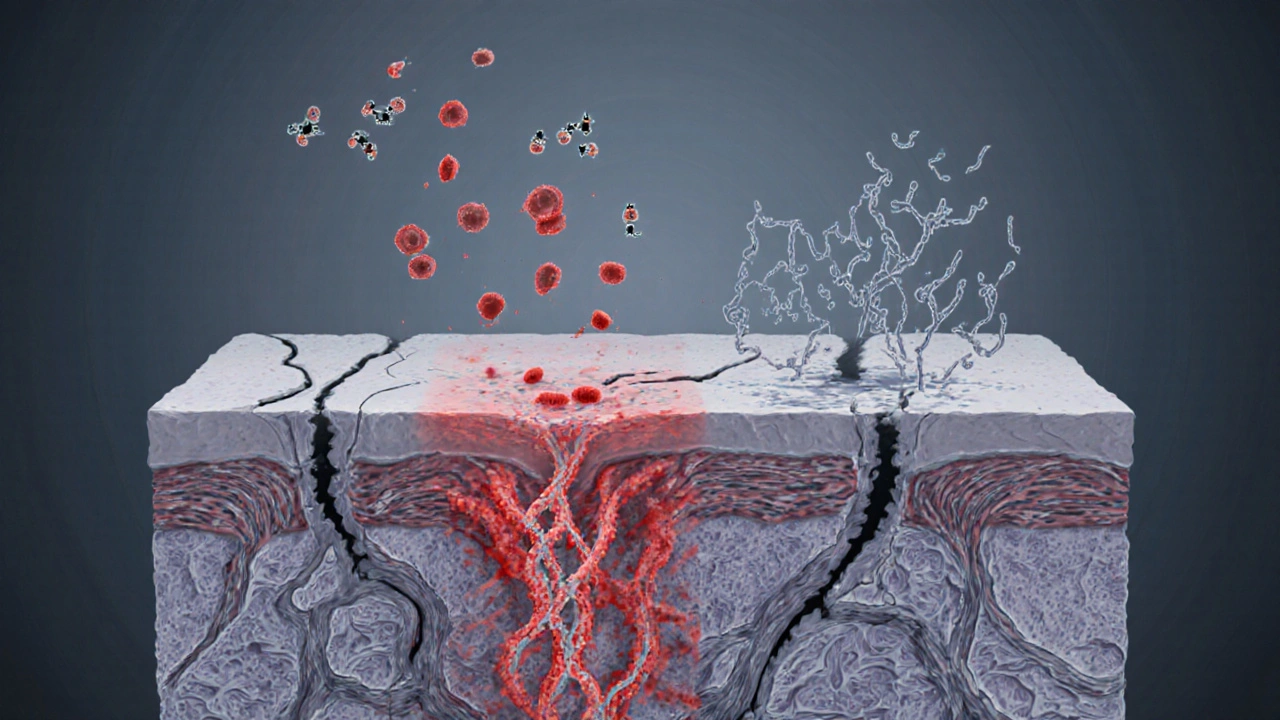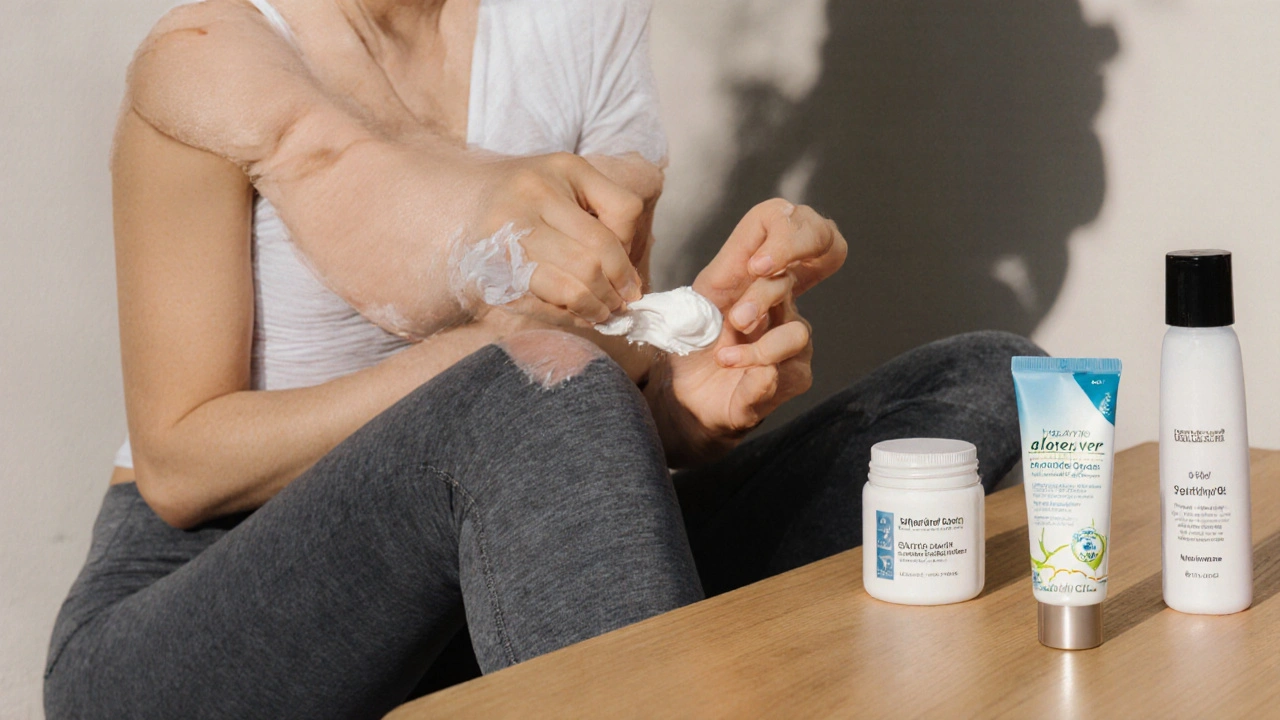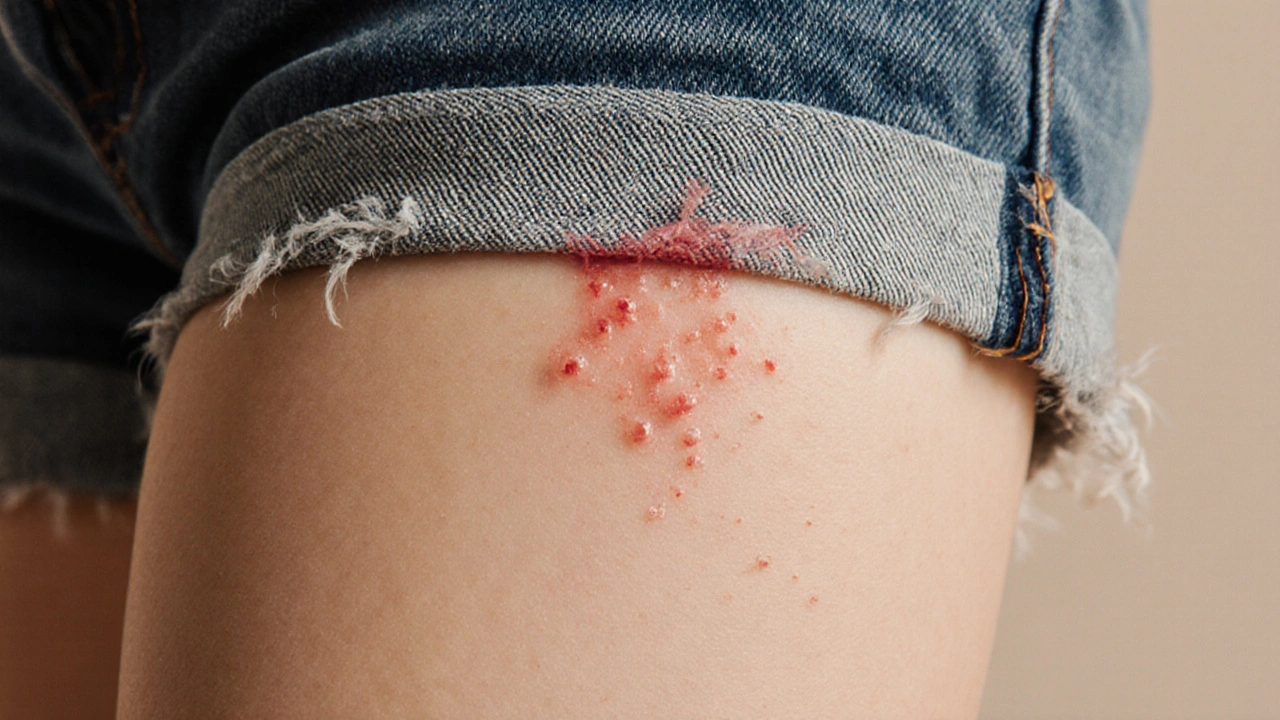Skin Chafe Risk Assessment Tool
Your Risk Assessment
Friction Score: --
--
--
When the skin experiences repeated rubbing, Skin chafe is surface irritation caused by friction or rubbing, resulting in redness, soreness, and microscopic tears. Over time that tiny irritation adds up, turning into visible signs of aging. Understanding skin chafe helps you protect your skin before the first fine line appears.
What Exactly Is Skin Chafe?
Skin chafe occurs when two surfaces-often skin against fabric, straps, or sports gear-rub together enough to damage the outermost layer, the stratum corneum. The damage is usually painless at first but triggers a cascade of inflammatory signals. Typical triggers include tightly‑fitted clothing, backpack straps, ill‑fitting shoes, and even repetitive motions in yoga or rowing.
How Friction Turns Into Skin Aging
Every time friction stresses the skin, it creates micro‑trauma. That trauma activates Inflammation the body’s immediate response to injury, releasing cytokines and enzymes that break down damaged tissue. While inflammation is essential for healing, chronic low‑grade inflammation accelerates the breakdown of two key matrix proteins: Collagen a fibrous protein that gives skin its strength and structure and Elastin the protein that allows skin to stretch and snap back. When these proteins degrade faster than they’re rebuilt, the skin loses firmness and begins to sag.
At the same time, friction disrupts the Barrier function the skin’s ability to retain moisture and block external irritants. A compromised barrier lets water escape, leading to dryness-a major contributor to fine lines.

The Direct Link to Wrinkles
Wrinkles are essentially collapsed collagen fibers. When friction‑induced inflammation repeatedly attacks collagen, the skin can’t maintain its smooth lattice. Over weeks and months, the skin’s surface shows creases where the damaged fibers can’t spring back. Studies from dermatology labs in 2023 showed that areas of chronic friction, such as the inner thighs of runners, develop deeper lines faster than non‑friction sites.
Additionally, the constant rubbing triggers oxidative stress, producing free radicals that further damage collagen and elastin. Without adequate antioxidant protection, these free radicals accelerate the aging process.
Common Culprits and Quick Fixes
| Cause | Typical Source | Prevention Strategy |
|---|---|---|
| Fabric friction | Denim, wool, synthetic blends | Choose breathable cotton or moisture‑wicking blends; use seamless seams |
| Strap pressure | Backpacks, sports bras, watch bands | Adjust fit, add padded liners, alternate strap positions daily |
| Shoe chafing | Rigid heels, new trainers | Break shoes in gradually, apply blister‑prevention sticks, wear moisture‑absorbing socks |
| Repetitive motion | Rowing, yoga, gymnastics | Use grip‑friendly gloves, apply barrier cream before sessions, hydrate skin after |
| Detergent residue | Clothing not rinsed thoroughly | Use fragrance‑free, dye‑free detergents; double‑rinse linens |
Everyday Prevention: Build a Protective Routine
- Moisturize regularly. A well‑hydrated skin surface reduces friction. Look for moisturizers containing Hyaluronic acid a humectant that pulls water into the skin and ceramides to restore barrier integrity.
- Apply a thin layer of a Barrier cream a product designed to create a protective film on the skin before activities that involve gear or tight clothing.
- Use sunscreen daily. UV exposure weakens collagen, making friction‑induced damage more visible.
- Choose clothing with flat seams, tag‑less designs, and moisture‑wicking fabrics. Seam‑free leggings and performance tees are especially gentle.
- Keep your skin clean but avoid over‑scrubbing. Harsh exfoliants can thin the stratum corneum, increasing susceptibility to chafe.

Repairing Damage: What to Use After Chafe Happens
If you’ve already experienced skin chafe, the goal is to calm inflammation, support collagen synthesis, and restore moisture.
- Anti‑inflammatory ingredients: Aloe vera, calendula, and bisabolol calm redness and reduce cytokine release.
- Collagen‑boosting actives: Retinoids (retinol or retinaldehyde) encourage new collagen formation. Start with low concentrations (0.25%) to avoid irritation.
- Antioxidants: Vitamin C, niacinamide, and green‑tea extract neutralize free radicals generated by friction.
- Repair‑focused moisturizers: Formulas with ceramides and shea butter seal in hydration and help rebuild the barrier.
For persistent or severe chafe, consider a professional consultation. Dermatologists can prescribe topical corticosteroids for acute inflammation or laser resurfacing for deep‑set wrinkles caused by chronic friction.
Quick Checklist to Keep Your Skin Smooth
- Identify high‑friction zones (inner thighs, underarms, shoulders).
- Swap rough fabrics for soft, breathable alternatives.
- Apply barrier cream before workouts or long trips.
- Maintain a daily moisturizing habit with hyaluronic acid + ceramides.
- Never skip sunscreen, even on cloudy days.
- Monitor any red or sore patches and treat them within 24‑48hours.
Frequently Asked Questions
Can skin chafe cause permanent wrinkles?
If left untreated, chronic friction can break down collagen faster than the body can repair it, leading to lasting lines. Early care-moisturizing, barrier protection, and anti‑inflammatory treatment-can often prevent permanence.
Are certain fabrics worse for skin chafe?
Rough fibers like wool, heavy denim, and some synthetic blends create more friction. Soft, moisture‑wicking fabrics such as modal, bamboo, or high‑quality cotton are gentler.
How soon should I apply a moisturizer after chafe?
Apply within the first hour while the skin is still slightly damp. This locks in moisture and supports barrier recovery.
Can I use retinol on irritated skin?
Wait until the irritation subsides. Starting with a low‑strength retinol after the skin has healed reduces the risk of worsening inflammation.
Is sunscreen needed if I’m indoors most of the day?
Yes. UV rays can penetrate windows, and everyday low‑level exposure still degrades collagen. A broad‑spectrum SPF30+ is a good baseline.

Dietra Jones
October 6, 2025 AT 17:46Yo, that chafe stuff really messes up ya skin.
Victoria Guldenstern
October 9, 2025 AT 07:43Oh great, another article telling us that rubbing our arms like a suitcase will cause wrinkles. Because we all just love discovering that our everyday lives are one big anti‑aging nightmare. The tone is so subtle you can barely feel the sarcasm. Then again, who doesn’t enjoy a well‑crafted warning about common clothing choices? Anyway, keep the data coming.
Bill Bolmeier
October 11, 2025 AT 21:40Honestly, folks, if you’re already hitting the gym, just toss on some breathable gear and you’ll dodge that chafe drama. Think of it like armor for your skin – you’d wear it in battle, right? Stay active, stay protected, and those wrinkles will stay far away. Let’s keep moving!
Darius Reed
October 14, 2025 AT 11:36lol i feel u, the article be like “hey you, stop wearin tight tees or u get old” – totally relatable but also kinda wavy. maybe they should add a meme.
Karen Richardson
October 17, 2025 AT 01:33To clarify, the term “chafe” refers to repetitive friction that can lead to inflammatory responses in the epidermis, not merely a vague “rubbing” sensation. The subsequent collagen degradation is a documented pathway toward premature wrinkle formation. Therefore, it is essential to differentiate between occasional irritation and chronic friction when assessing risk.
AnGeL Zamorano Orozco
October 19, 2025 AT 15:30Listen up, everyone, because I’m about to blow your mind about skin chafe and the cruel march of time. First, the friction you feel from a stupid pair of leggings isn’t just a harmless itch; it’s a microscopic assault on your dermal layers. Second, every micro‑tear releases inflammatory cytokines that act like tiny gremlins, chewing away at collagen like it’s a snack. Third, the body’s natural repair mechanisms get overwhelmed, and instead of rebuilding firm tissue, it lays down lax, wrinkled scar tissue. Fourth, you might think a little redness is nothing, but that redness is the early warning flare of a long‑term problem. Fifth, chronic irritation triggers oxidative stress, which further accelerates the breakdown of elastin fibers. Sixth, if you add sunscreen neglect to the mix, you’re basically inviting UV rays to join the party of destruction. Seventh, tight clothing creates a pressure gradient that traps heat, making the skin’s enzymes work overtime in the worst possible way. Eighth, strap friction from backpacks or watches isn’t just a nuisance; it’s a constant reminder that your skin is being sandpapered daily. Ninth, harsh soaps strip away the protective lipid barrier, leaving the skin raw and vulnerable. Tenth, people who ignore these signs often end up with deep set lines that no cream can fully erase. Eleventh, the emotional toll of looking older than your years can be devastating to self‑esteem. Twelfth, it’s not just vanity; it’s about maintaining the health and resilience of your largest organ. Thirteenth, simple changes like loose fabrics, silicone sleeves, and gentle cleansers can halt the cascade. Fourteenth, hydration and a balanced diet supply the building blocks your skin needs to repair itself. Fifteenth, consistent use of a broad‑spectrum SPF acts like a shield, protecting the newly rebuilt collagen from UV sabotage. Finally, the power to prevent premature aging is literally in your hands, or rather, in the clothes you choose to wear every day.
Cynthia Petersen
October 22, 2025 AT 05:26Wow, that was a masterclass in drama – I almost needed a tissue for the emotions. Still, point taken: less friction, more skin love.
Marcia Hayes
October 24, 2025 AT 19:23Honestly, just swap those tight leggings for something softer. Your skin will thank you, and you’ll still look great.
Danielle de Oliveira Rosa
October 27, 2025 AT 09:20One might consider clothing as an extension of self‑expression, yet when it becomes a source of harm, the balance tips. Choosing comfort does not diminish style; it elevates wellbeing.
Tarun Rajput
October 29, 2025 AT 23:16In consideration of the previously presented data regarding friction‑induced dermal degradation, it is advisable to integrate apparel composed of low‑friction polymers or natural fibers into one's quotidian wardrobe. Such a practice not only mitigates the mechanical stressors imposed upon the epidermal strata but also harmonizes with the physiological processes of cellular regeneration. Moreover, the adoption of a comprehensive skin‑care regimen, encompassing gentle cleansers and steadfast photoprotection, constitutes a synergistic approach to forestalling the onset of premature rhytides. Consequently, the confluence of these measures engenders a robust barrier against the inexorable advance of cutaneous ageing.
Joe Evans
November 1, 2025 AT 13:13Great summary! 😄 I totally agree – good fabrics + sunscreen = happy skin 😎👍
Colin Boyd
November 4, 2025 AT 03:10While the admonitions against chafe are well‑intentioned, one must not overlook the adaptive capacity of the skin to mechanical stimuli which can, in certain contexts, promote resilience rather than degeneration
John Petter
November 6, 2025 AT 17:06Ah, the romantic notion of “adaptive stress” – perhaps more suited to a philosophy lecture than a practical skincare guide. Simplicity often prevails.
Annie Tian
November 9, 2025 AT 07:03Remember, small adjustments today-like choosing breathable fabrics and applying sunscreen daily-can yield big, youthful results tomorrow.